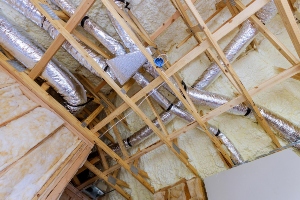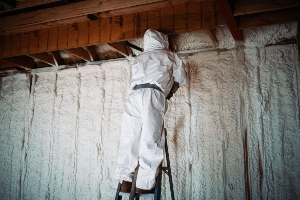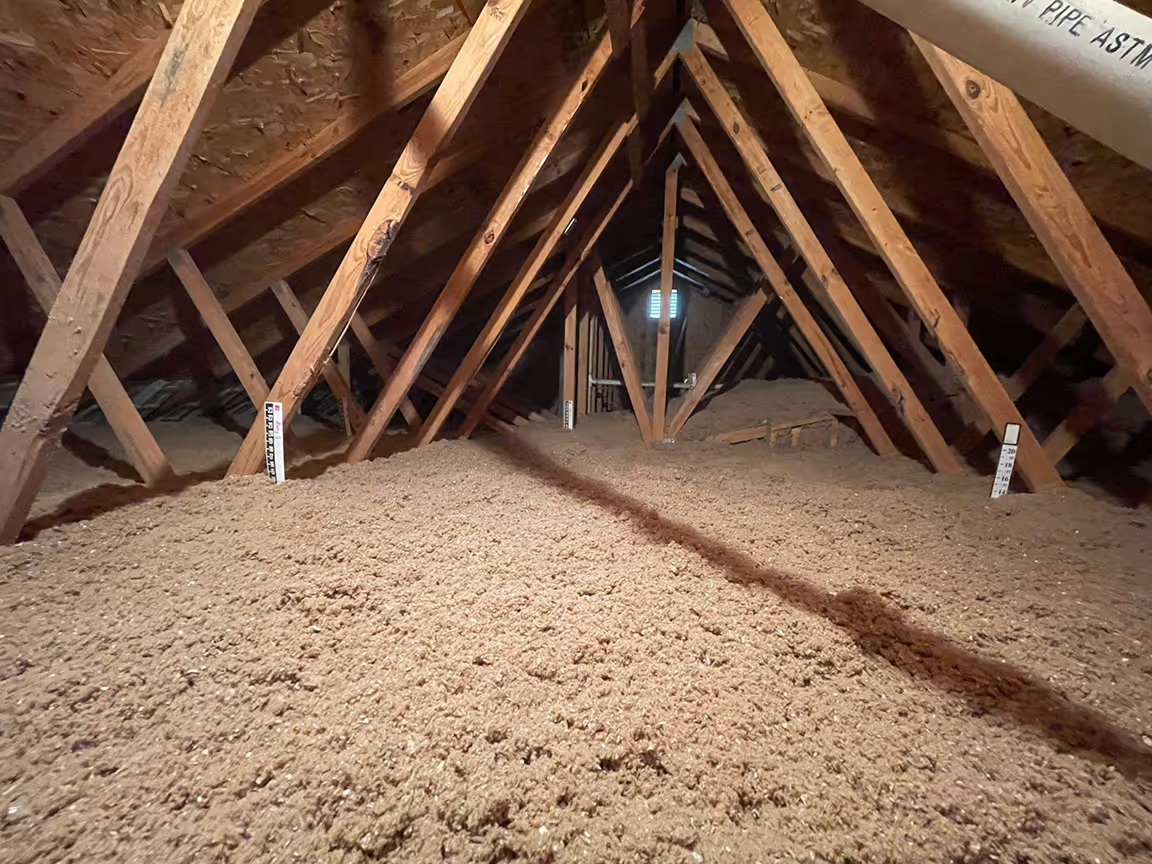Studies show that insulating your home can reduce energy costs by 15-40%, depending on your current insulation status and climate zone. This is because insulation creates a barrier that keeps warm air inside during winter and outside during summer, reducing how hard your HVAC system needs to work.
Beyond the financial benefits, proper insulation improves home comfort by eliminating cold spots and drafts. The combination of lower energy bills and increased comfort makes insulation one of the smartest home improvements you can make.
The Importance of Insulation for Energy Efficiency
Properly installed insulation creates a thermal envelope that maintains comfortable temperatures while reducing the workload on heating and cooling systems.
Understanding Heat Loss and Insulation Benefits
Heat naturally flows from warmer to cooler areas until there’s no temperature difference. In winter, heat escapes from your warm home to the cold outdoors. In summer, outdoor heat tries to enter your cool home. Insulation slows this heat transfer process.
Sealing air leaks and adding insulation are among the most cost-effective ways to improve energy efficiency. Homeowners can save an average of 15% on heating and cooling costs by properly air sealing their homes. Insulation also creates more consistent indoor temperatures by eliminating cold spots and drafts, reduces noise transmission, and improves indoor air quality by controlling moisture.
Comparing R-Values and Insulation Types
R-value measures insulation’s thermal resistance (how effectively it blocks heat flow), and higher R-values indicate better insulating performance. The Department of Energy recommends different R-values based on your climate zone and the area being insulated.
The best insulation choice depends on your home’s needs, climate, and budget. Common insulation types include:
- Fiberglass: Widely used, moderate R-value (2.2-4.3 per inch)
- Cellulose: Made from recycled paper, good R-value (3.1-3.8 per inch)
- Spray foam: Highest R-value (3.7-6.5 per inch) and excellent air sealing
- Rigid foam boards: Great for basements and exterior walls (4-6.5 per inch)
Assessing Your Home’s Insulation Needs
Before upgrading your insulation, it’s important to determine where your home is losing energy. A proper assessment helps target the areas that will give you the biggest return on investment.
Identifying Common Areas of Heat Loss
Most homes lose heat through predictable areas, and the attic typically accounts for 25-30% of heat loss in a poorly insulated home. Walls represent another 15-20% of potential heat escape. Windows and doors are also common culprits, with single-pane windows losing up to twice as much heat as double-pane options. Meanwhile, basements and crawl spaces can account for 15% of heat loss when left uninsulated.
Additionally, recessed lighting fixtures, electrical outlets on exterior walls, and chimney areas often create thermal bridges where heat easily escapes. Pay special attention to these spots during your assessment. A home energy audit can precisely identify your problem areas so they can be addressed.
Evaluating Attic Insulation and Ventilation
Check your attic insulation depth against recommended R-values for your climate zone, and look for signs of moisture damage or compression in existing insulation. Wet or flattened insulation loses much of its effectiveness and should be replaced.
Proper ventilation works hand-in-hand with insulation, so ensure soffit vents aren’t blocked by insulation and that ridge or gable vents create good airflow. This prevents moisture buildup that can damage both your insulation and your roof structure. Examine the attic hatch or door, as this is often overlooked but can be a significant source of heat loss. Adding weather stripping and insulation to this access point can yield immediate benefits.
Detecting and Sealing Drafts for Improved Efficiency
Air leaks can reduce your insulation’s effectiveness by up to 30%. A simple way to detect drafts is to hold a lit incense stick near suspected areas on a windy day. Movement of the smoke indicates air leakage.
Common draft areas include:
- Window and door frames
- Electrical outlets and switches on exterior walls
- Baseboards and crown molding
- Plumbing and utility entry points
- Recessed lights
Weather stripping and caulk are inexpensive solutions for many draft problems, but for larger gaps, expanding foam insulation is best. Also, adding door sweeps and weather stripping to interior doors to unheated spaces like garages or basements can significantly reduce heat loss to these areas.
Cost-Benefit Analysis of Home Insulation
Investing in home insulation offers both immediate and long-term financial benefits through reduced energy consumption. Proper analysis of these benefits can help homeowners make informed decisions about insulation upgrades.
Calculating Energy Savings from Insulation Upgrades
When evaluating insulation projects, consider both upfront costs and potential savings. Most homeowners can save approximately 15% on heating and cooling costs after properly insulating their homes. For a complete picture, calculate your current annual energy expenses and apply this percentage.
For example, if you spend $2,400 yearly on heating and cooling, proper insulation might save you about $360 annually. Professional insulation upgrades typically range from $1,500-$3,000, depending on home size and insulation type. The payback period usually falls between 3-7 years for most projects, and after this point, all savings represent direct financial benefits.
Understanding Heating and Cooling Cost Reductions
Insulation works by creating a thermal barrier that prevents warm air from escaping in winter and hot air from entering in summer. This reduction in heat transfer can decrease energy usage by up to 45% in some homes.
The actual savings depend on several factors:
- Climate zone: Colder regions typically see higher heating savings
- Current insulation levels: Poorly insulated homes benefit most
- Insulation quality: Higher R-value materials deliver better results
- Installation quality: Professional installation maximizes effectiveness
Beyond monthly bills, proper insulation reduces wear on HVAC systems, potentially extending their lifespan and decreasing maintenance costs. This provides additional financial benefits not immediately visible on utility statements.
Maintaining an Energy-Efficient and Comfortable Home
Keeping your home energy efficient isn’t a one-time project but requires ongoing attention to insulation and proper airflow to create the perfect balance.
Strategies for Ongoing Energy Savings
- Check your insulation annually for signs of settling or damage, especially in attics and crawl spaces, where problems often begin.
- Seal air leaks around windows, doors, and other openings with weather stripping or caulk.
- Install a programmable thermostat to automatically adjust temperatures when you’re away or sleeping. This simple device can save 10-15% on your annual energy bills.
- Add insulating covers to electrical outlets on exterior walls, as these are often overlooked sources of energy loss.
- Clean or replace HVAC filters every 1-3 months to ensure your system runs efficiently. Dirty filters force your system to work harder and use more energy.
Balancing Insulation and Ventilation for Optimal Home Comfort
Good ventilation prevents moisture buildup and maintains healthy indoor air quality. To improve ventilation, install exhaust fans in high-moisture areas like bathrooms and kitchens. You can also use ceiling fans to improve air circulation and comfort without adjusting your thermostat. In summer, run fans counterclockwise; in winter, run them clockwise at low speed.
Additionally, consider a heat recovery ventilator (HRV) if your home is tightly sealed. This system brings in fresh air while capturing heat from outgoing air, maintaining efficiency.
Get in touch to arrange an energy audit of your home to ensure it is sufficiently insulated.





